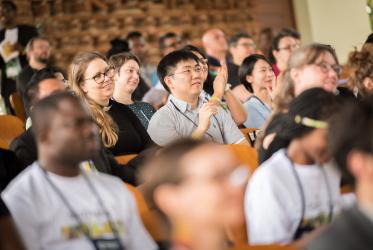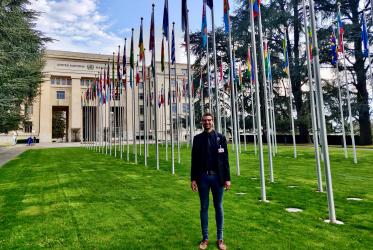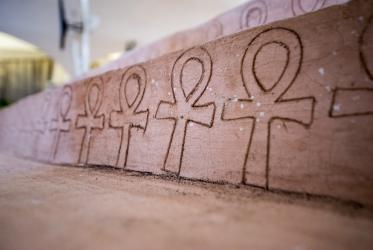* By Odair Pedroso Mateus
As Rev. Marc Gallopin welcomes the new Bossey students to the Reformed congregation in Céligny, Switzerland, this sunny Sunday, 13 October, the name of another Céligny pastor comes to my mind: Arnold Mobbs.
I see Mobbs right outside the Bossey dining hall, sitting next to the American evangelist Billy Graham, who is in a conversation with the first World Council of Churches general secretary, the Dutch ecumenist Visser ‘t Hooft. Graham seems to be asking Visser ‘t Hooft what on earth he means by the imperative of making visible the Una sancta, while Visser ‘t Hooft seems to be trying – rather stoically I would say - to understand how on earth one cannot possibly embrace it.
Mobbs was the pastor of the Céligny parish from 1950 to 1975. He had studied at Union Theological Seminary in New York under Reinhold Niebuhr. In the beginning of the 1980s, by the time I was a Bossey student, he dedicated to Bossey a short monography with a long title: “The Origins and first years of the Ecumenical Institute of Bossey – A collection of personal memories”. And signed: “By Arnold Mobbs – ancien pasteur de Céligny”. Many were the years in which that brochure, together her older sister titled “Bossey – Two vignettes from the early years” would be on a display for sale at the desk of the Bossey reception.
It was Mobbs who drew my attention to the fact that the Ecumenical Institute, established in 1946, has what he called a “pre-history”: Moved by the ecumenical vision of the Swiss Adolf Keller, one of the pioneers of the Movement on Life and Work and of the Federation of Swiss Protestant Churches, the Faculty of Theology of the University of Geneva held between 1934 and 1938 four sessions of its “International Theological and Ecumenical Seminary”.
You may be familiar with the names of some of the theologians who were guests of the Geneva Ecumenical Seminary: Emil Brunner, Visser ’t Hooft, Martin Dibelius, and Paul Tillich. Karl Barth lectured in 1935 to 85 students on “The Church and the Churches”. Visser ‘t Hooft probably did not forget that lecture when, 11 years later, he began to draft what is known as the “Toronto Statement”, a foundational formulation of the WCC self-understanding. Mobbs, who then was a pastor in France, was a member of the team. He was in charge of organising study visits to international organisations, excursions in the region, and hospitality for the students.
Bossey students with members of Celigny congregation. Photo: Lakshman Daniel
Mobbs wanted us to remember well the year of grace of 1946.
With a grant of 500,000 dollars made the previous year by the Baptist Nelson Rockefeller, Visser ‘t Hooft was then looking for a home for the future Ecumenical Institute, whose mission would be to equip biblically and theologically lay people engaged in the reconstruction of Europe and in the renewal and unity of the churches.
Rockefeller’s grant to Bossey, which was not the last one, reminds me that the relationship of bankers with the ecumenical movement may deserve further research. Geneva’s Georges Lombard was the first treasurer of Bossey and for more than 20 years the treasurer of the World Alliance of Reformed Churches; Gustave Hentsch contributed to the work of the WCC; the Pictet bankers, also from Geneva, generously contributed to the renovation of the Bossey library in recent years; and J. P. Morgan had been, back in 1910, the first treasurer of the Movement for a World Conference on Faith and Order. Fundraising should not be an ecumenical problem in our days.
The Céligny historian Guillaume Fatio helped Visser ‘t Hooft in his search. He suggested the “Château de Bossey”, then owned by Colonel Fernand Chenevière, as a possibility. Visser ‘t Hooft did not find the place unforgettable. Nor did its first professor, Suzanne de Dietrich. Years later, Visser ‘t Hooft would write that when Robert Mackie and him visited Bossey for the first time, on a cold, foggy winter afternoon, “we found a house which looked rather dirty and rundown”. But after imagining how Bossey would look like “on a nice summer day”, himself and Mackie said to each other: “this is it”.
Towards the end of his chapter on 1946, when it comes the moment of describing the inauguration of Bossey, Mobbs becomes eloquent, indeed lyric: “and behold, in the sumptuous panorama of autumnal nature, the great day of 25 October 1946, which sees the crowning of the efforts of the pioneers. The Ecumenical Institute is officially inaugurated…”
In this morning service in Céligny, four students - from India, Cuba, Madagascar, and Sweden - shared words of witness about the search for Christian unity in their countries. Other four, from Kenya, Italy, Thailand and the United States offered intercessory prayers.
Pastor Gallopin invited the students to say their names, countries of origin and church affiliation. As names, cultures, Christian traditions were shared in a flow, the eyes of the members of the congregations were shining. Were he with us this morning, Mobbs would certainly be happy: his parishioners made a “real, though imperfect” experience of what I imagine Visser ‘t Hooft preached to Billy Graham right outside the Bossey dining hall: the imperative of making visible the Una Sancta.
*Odair Pedroso Mateus is a director of the Faith and Order Commission of the World Council of Churches (WCC).








